Me, Make, Meet: How to Manage a UX Manager’s Calendar
Most of us know the story. You start your career as a front-line designer, researcher, coder, or writer. You love what you do. You love being a part of the process of making new stuff. Or making old stuff better. By some random series of events – some might say misfortune – someone eventually suggests that you have leadership potential and gives you a team of anxious/ambitious new grads to manage. Or perhaps your freelance work is so successful that you’ve begun to hire junior designers to take on some of the load. Either way, your responsibilities have broadened significantly. Now there’s less time for you to do what got you here in the first place – doing the work yourself. Meetings are now jamming your calendar. You have little time for yourself. Forget hands-on project work.
It feels like a rat race. But does it have to be this way?
I don’t believe so. The answer lies in how you manage your calendar. Calendar planning tactics seem like an odd topic for a UX manager blog, but for me at least, it’s the essential tool to enable me to create the space to work, at the level I want to work at.
Here’s a typical week in my calendar:
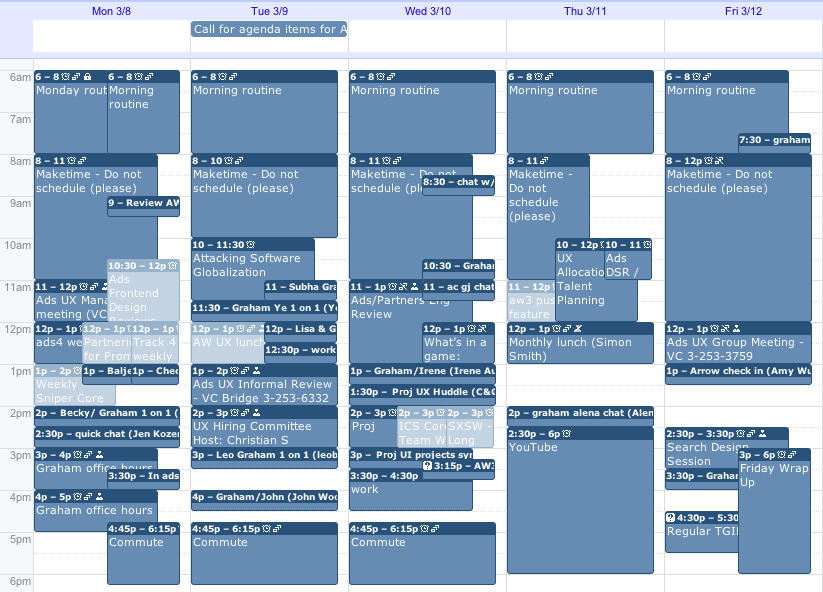
At a glance, my schedule looks like a mess. But there’s a method to the messiness. Before turning to the calendar, I should talk a little about goals.
Start with personal goals
It’s incredibly easy to get caught up in the day-to-day politics or firefighting or water-treading of any job that you can easily lose sight of why you’re working in the first place. To prevent myself from getting sucked into this vortex, I have goals. They keep me honest. I’ve written them in Evernote so that they are with me on the desktop or on the road. I don’t look at them every day, maybe once a month. But they remind me of why I’m here, why I’m working. Without them, I’d be lost. There’s nothing earth shattering about them. They're simple: spend as much time with my wife and kids as I can, be the best manager I can be, eat my brussels sprouts, etc. I have about 20 of them.
When planning my calendar, one goal is particularly relevant: I will design.
There’s an aspect of management philosophy here that some will disagree with. I believe that by doing hands-on work, by cranking out design deliverables, by launching projects, not only am I meeting my desire to design, but I’m also gaining a better sense of what my team members are going through – because I’m going through it with them. Hopefully, I’m a better manager as a result. The challenge, of course, is to get the time balance right so that you’re able to support your team members effectively, support your stakeholders, and successfully deliver on project work. My calendar is a direct reflection of my attempt to get this balance right. Even if you don’t believe in this approach, or if you feel that UX managers should be purely people managers, you’ll still need to balance time for yourself, your team and their stakeholders.
Let’s take a deeper look at a typical week, and you’ll see what I mean.
Daily activities
Every work day, I attempt to maintain three time zones: “me time,” “make time,” and “meet time.”
Me time
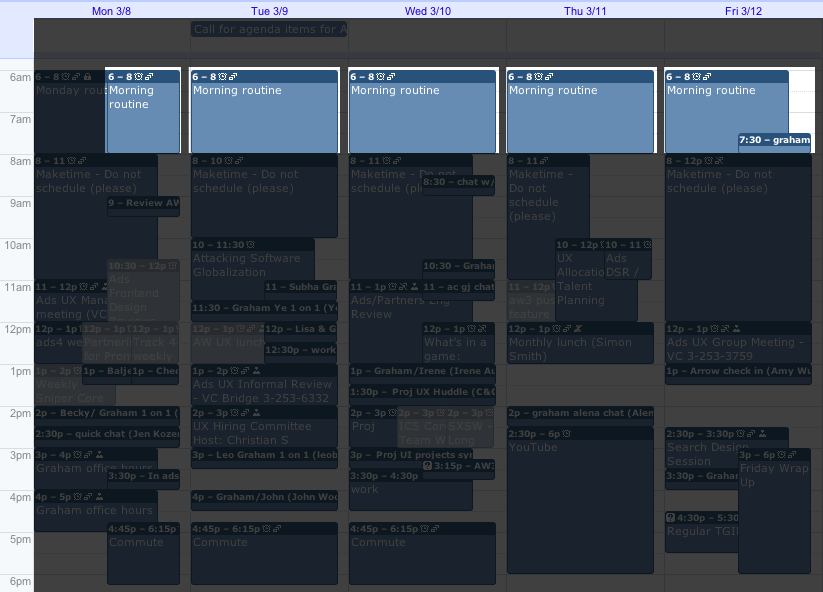
Every morning I have a personal routine. I try to do something that I’m interested in beyond project or management work. I’ll collect articles that my wife might find interesting and forward them to her. For myself, I’ll read about jquery, game mechanics, or baseball trades. I’ll listen to Jon Kabat-Zinn, Amy Goodman, or AC/DC. “Me time” is replenishment time. If I’m going to drive myself through the rest of the day successfully, I need to make sure that I’m personally on a full tank of gas, oil changed, tires rotated, etc. That’s the purpose of “me time.”
I’m a morning person so I – umm – do this in the morning. Six till eight. You could do it anytime. But I recommend doing it, every day. It makes a huge difference to my level of motivation and excitement about work and everything else.
Make time
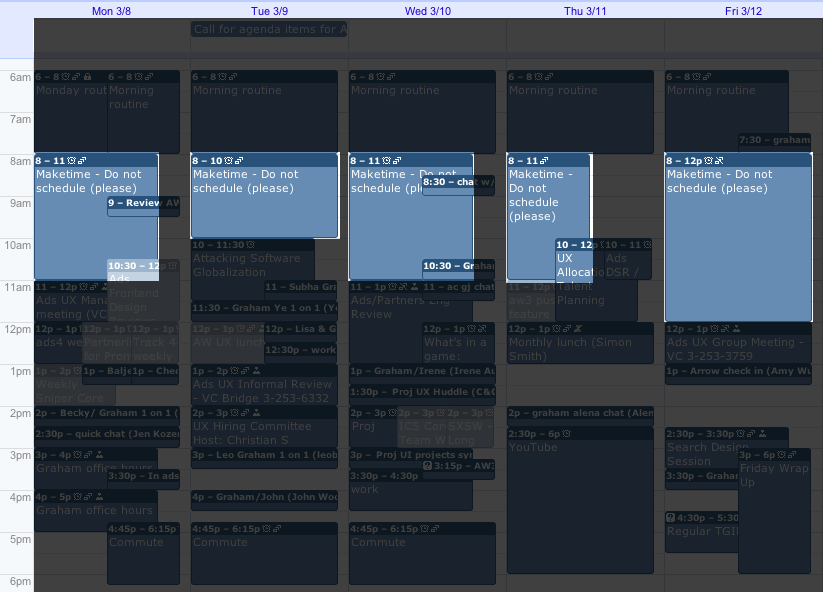
From 8 am till about 11 am I have “make time.” This is when I design. It could be conceptual work or detailed production work. It could be a new idea I’m working on or a specific deliverable for an in-flight Google project. It doesn’t matter. All of my design work – or at least the stuff that doesn’t require anyone else – happens during “make time.” I used to distribute this time across my work day – an hour here, an hour there. That didn’t work (although I occasionally still do this when crunched on a deliverable). I need to have at least 3 hours of continuous, uninterrupted time to get deep on the work and make significant progress or produce something that I can feel good about.
Protecting “make time” has been tough. Really tough. As you can see from the calendar, some meetings end up creeping into “make time.” Sometimes I’ll allow an important meeting to settle into this space, but I try to do so as little as possible. Caving in and scheduling over “make time” can be a sign to others that you’re not serious about managing your time. It’s a battle, but it’s worth it. Every day, I feel like I’m productive. Certainly, some days are more productive than others, but every day is productive in some way, thanks to “make time.”
Meet time
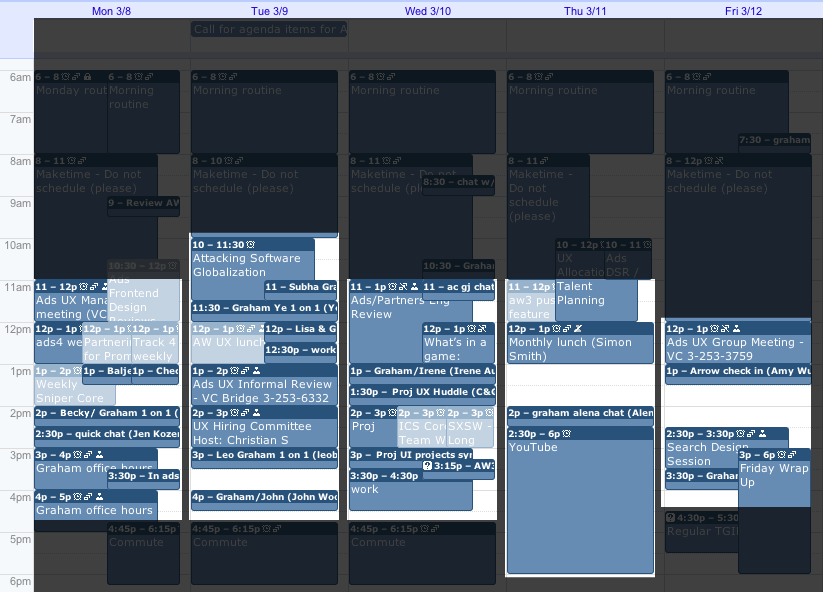
Meetings make up the rest of my day. Many people, including many Googlers, believe that all meetings are a waste of time because they suck time that might be better spent working. I’m not one of these people. Yes, some meetings do waste time, but this is avoidable – and a topic for another blog post. But if you ever want to achieve anything of a significant size, you need to do so with a team of people. And if you’re doing anything with a team of people, you need to talk with them, which in many cases means meetings. Sorry to be so basic, but not everyone gets this.
There are a handful of “meet time” categories that I allow onto my calendar.
I put a premium on one on one relationships with my team members, my fellow Google UX managers, and of course, my own manager. So a good chunk of “meet time” is allocated to these one on ones. Right now, I tend to do one on ones every other week – sometimes every four weeks – for 30 minutes each. If people need additional time, I have office hours on Monday afternoons. If no one comes to my office hours, I have a 2-hour block to process email. Sweet.
Here’s my one on one schedule for the sample week:
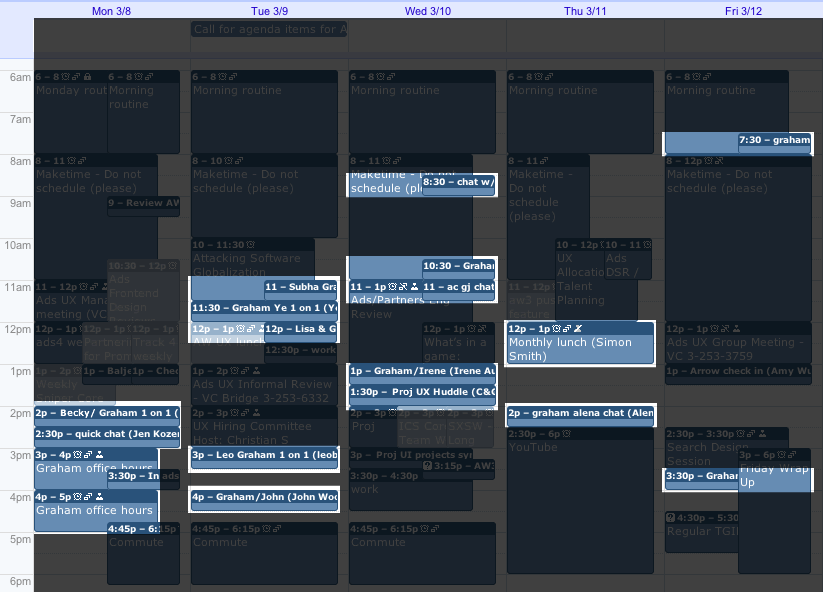
As I’ve already mentioned, I attempt to make design work a priority. To successfully execute on design projects, you obviously need to meet with business partners from product management and engineering to discuss project strategy and to present and discuss work. So, another chunk of my “meet time” is allocated to these kinds of activities. These are projects which I’m either directly responsible for or contributing to. I avoid meetings for projects that my team members are working on without my direct involvement. I let them own their work and their relationships and give guidance during one on ones or reviews.
Here’s my project meeting schedule:

If you care about the quality of work being done in the world that you manage, design reviews are a must. And if you care about how your team’s work is communicated to stakeholders, participation in engineering and product reviews can be key. My research partner and I check in on the week’s schedule of reviews every Monday and determine what we’ll attend and what we need to take last-minute action on.
Here’s the sample week’s review schedule. No product reviews this particular week:
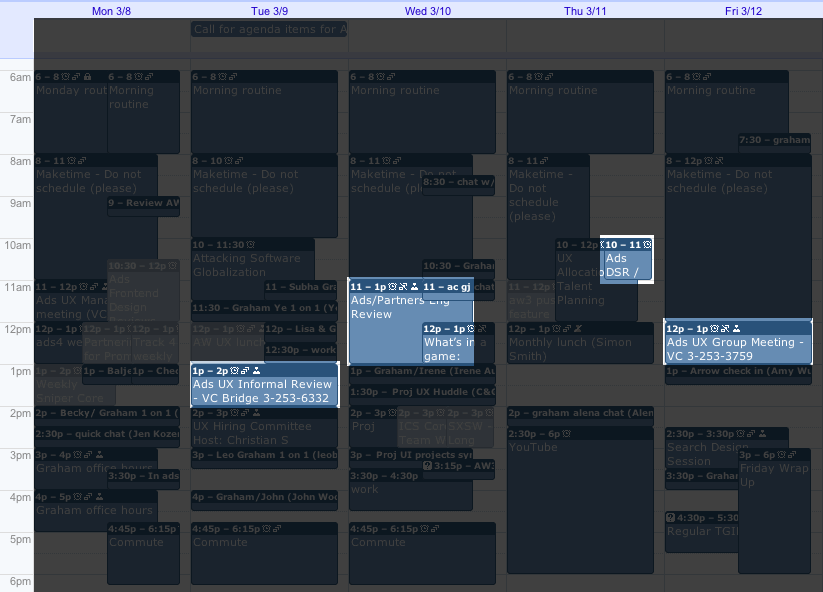
If you have a plan on how to grow your user experience team and its members, you occasionally need to check in on how that plan is performing, make adjustments, weed out problems, and such. Management team meetings carry out this function. Some are weekly, some quarterly, some yearly. Some are at 50,000 feet level, some at 1,000, and some on the runway.
I have a few blocks for these kinds of meetings:

Working at Google has its perks. But you’ve got to show up to enjoy them. So some weeks, I schedule an hour or two to check out a tech talk or grab a beer at TGIF.

And believe it or not, we actually get to go home at night. I check out a bit earlier than most people because I want to get home before the kids get too sleepy. Googlers can be night owls, so I’m sure to schedule my commute time to make it clear that I’m not going to be around.
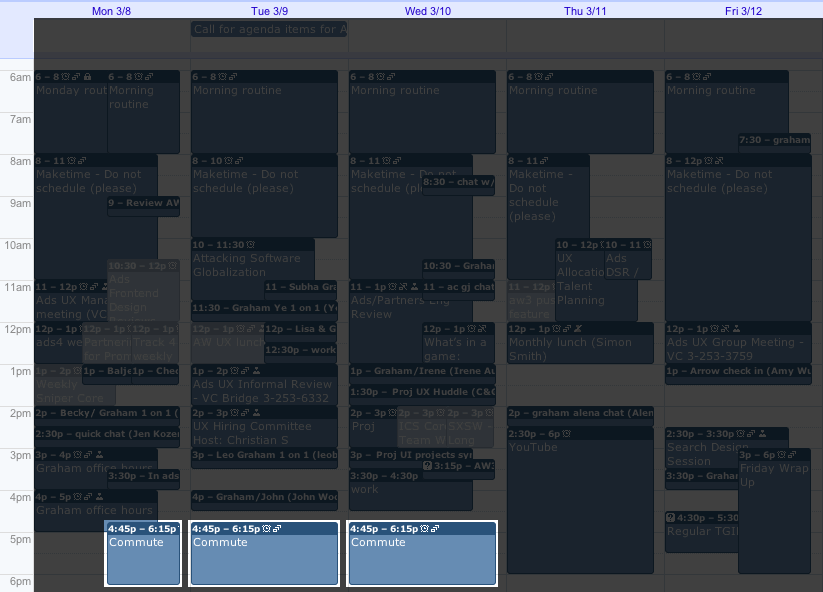
It works for me
So that’s my strategy for making my calendar work for me. What looks like an insanely chaotic schedule is a somewhat-structured plan to maximize my productivity while meeting the needs of my team and stakeholders. If you’re thinking about trying this, be warned that your colleagues may be quite annoyed by this at first. You’re no longer available according to their schedule. That will be a tough nut to swallow for some. But if you prioritize according to your personal goals, and you make room for some flexibility (with time blocks such as office hours), you can keep your most important colleagues happy while fulfilling your desires, needs, ambitions. In summary, the plan is to schedule:
- Me time: get refueled so that you can perform to your potential
- Make time: continuous, uninterrupted time to design
- Meet time:
- for one on ones,
- project team meetings,
- design, eng, product reviews,
- management team planning meetings, and
- google-y fun time.
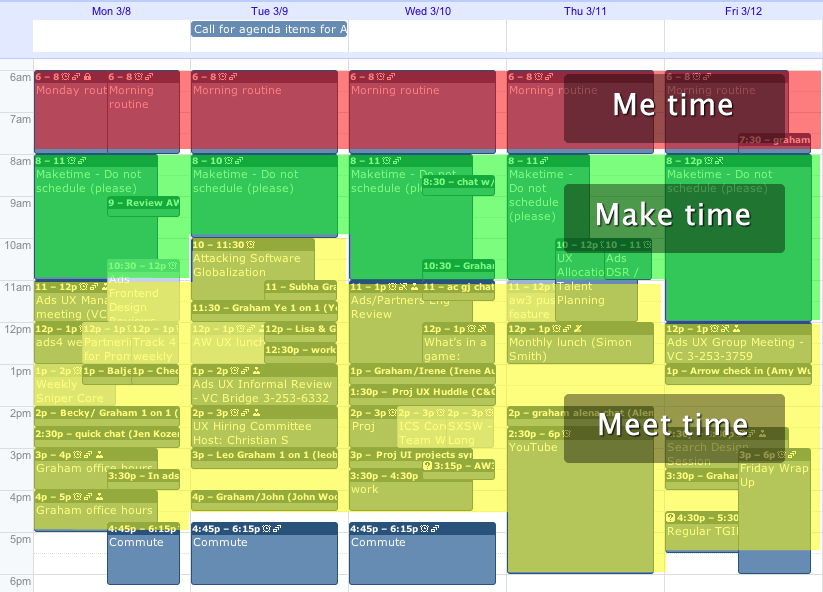
I hope you find this system useful. And let me know if you have any suggestions for improving it, or if you have a better system.
Subscribe to graham jenkin
Get the latest posts delivered right to your inbox

